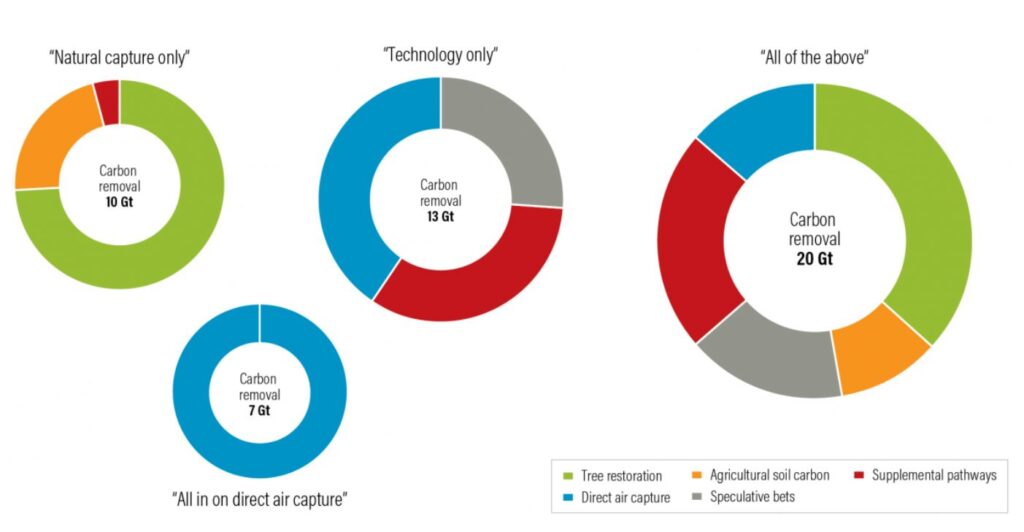Carbon credits can basically be divided into two main categories: carbon avoidance credits and carbon removal credits. Read on to learn the difference between them and find out why some corporations are going after carbon removal credits.
Carbon avoidance and carbon removal
Carbon avoidance credits are those that come from Reduced Emission from Deforestation and Forest Degradation (REDD+ credits) and renewable energy projects, to name a few. These projects are developed to avoid the alternative, which emits carbon dioxide into the atmosphere. In the examples mentioned before, the alternative would be to chop down those trees for agriculture or using energy produced by fossil fuels.
Due to the amount of greenhouse gasses already in the atmosphere, reducing greenhouse gas emissions is indispensable. According to the United Nations we need to remove 10 billion tons of carbon dioxide annually by 2050 to meet the goals of the Paris Agreement.
Before getting into why some corporations prefer carbon removal credits, let’s start by the basics. Carbon removal is the process of removing carbon dioxide from the atmosphere and locking it away. Removed emissions can only be achieved if the entire process (life cycle) removes more emissions from the atmosphere than the process itself produces.
The following graphic shows some Carbon Removal Deployment Scenarios

The permanence of removed emissions is related to long-term storage of carbon in terrestrial and aquatic carbon sinks, as well as in geological structures or chemical compounds in a situation of carbon capture and storage.
More specifically, ecosystem-based activities for avoiding carbon emissions rely on long-term changes in management practices and the stability of ecosystems to act as a carbon sink.
Carbon removal methods
Carbon removal methods include natural strategies such as tree restoration and agricultural soil management; high-tech strategies like direct air capture and enhanced mineralization, among others. Carbon removal can also be achieved by upgrading terrestrial carbon. Approaches to improving terrestrial carbon sinks include afforestation, reforestation, and optimization of forest management and agricultural practices.
It is also possible to achieve removal through marine carbon sinks or by technological means. For example, technical means of CO2 removal include bioenergy production combined with geological carbon storage or chemical processes that directly capture carbon dioxide from the air combined with geological carbon storage.
Carbon removal is important because 15-40% of the carbon dioxide emitted by mankind will remain in the atmosphere for up to a thousand years, and approximately 10-25% will persist for tens of thousands of years. Strategies that actively remove CO2 from the atmosphere are needed to achieve climate goals.
World Resources Institute points out at some ideas for carbon removal, which are presented below:
- Forests: planting massive new forests (afforestation/reforestation). Expanding, restoring and managing forests to encourage greater carbon sequestration can harness the power of photosynthesis, converting carbon dioxide from the air into carbon stored in wood and soil.
- Farms: soils naturally store carbon, but agricultural soils have a large deficit due to intensive use. Increasing soil carbon is also good for farmers and ranchers, as it can improve soil health and crop yields. Tree integration on farms can also remove carbon while providing other benefits, such as shade and fodder for livestock.
- Bio-energy with Carbon Capture and Storage (BECCS): BECCS is the process of using biomass for energy in the industrial, energy, or transport sectors. It captures emissions before they are returned to the atmosphere and then stores that captured carbon, either underground or in long-lived products such as concrete. BECCS is another way of using photosynthesis to combat climate change. However, it is much more complicated than planting trees or managing soil.
- Direct Air Capture: a technological method that uses chemical reactions to capture CO2 from the atmosphere. This new technology is similar to the carbon capture and storage technology used to capture emissions from sources such as power plants and industrial facilities. The difference is that direct air capture removes excess carbon directly from the atmosphere, rather than capturing it at the source.
So, why do some corporations prefer carbon removal credits?
A rising number of corporations believe that avoidance credits are simply not enough to combat climate change quickly. This goes in line with the philosophy of Science Based Targets. The Science Based Targets initiative demands from the companies that sign the pledge to work on long-term deep decarbonization targets of 90-95 % across all scopes of their carbon footprint. Once they reach this point, they accept that only 5-10 % of residual emissions can be neutralized with the use of high quality carbon removal credits (not avoidance credits).
Companies like Microsoft, Ikea, Starbucks and AstraZeneca are just (or mostly) after carbon removal credits. While some companies have pledged to become carbon neutral, these companies have plans to become carbon negative. What does this mean? That they have commited to remove more carbon dioxide than they emit. To do so, carbon removal credits are the only option.
Are you interested in removing carbon from the atmosphere as well? At ALLCOT Trading we trade carbon removal projects credits and we are always looking forward to promoting additional sustainable impact with every transaction. If you want to achieve this in a fair, transparent and win-win scenario, contact us and together we will make it happen.



